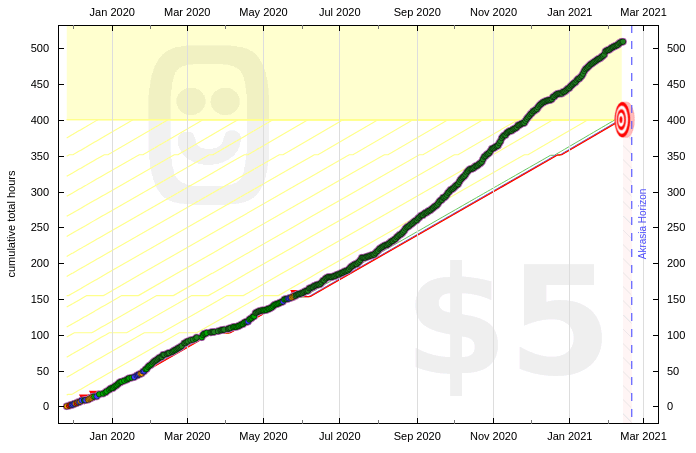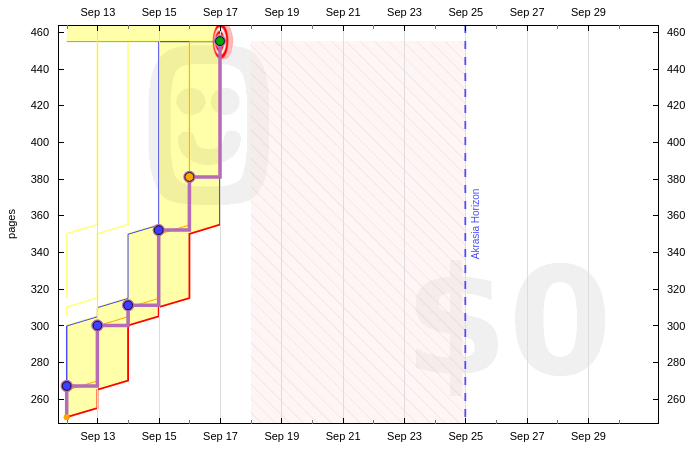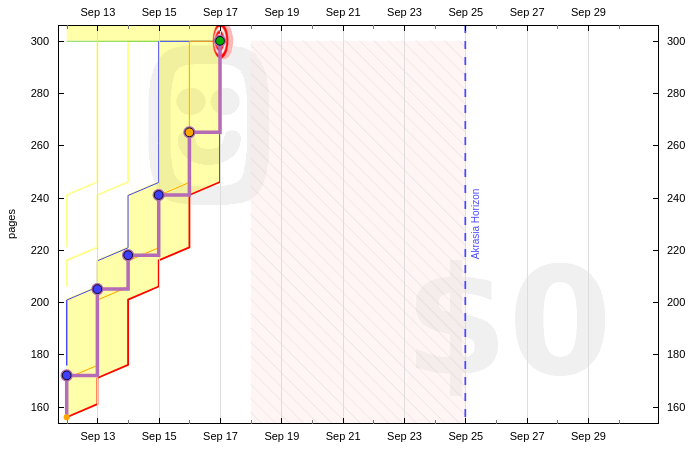
I want to read more books.
I already read a lot of books, but I want to read more! It sounds like that should be a simple thing to beemind. Do-more graph, set the rate to however many books I want to read per day/month/year, go!
It has turned out that it’s a lot more complicated than that, and because it’s something that I’ve been trying to figure out since I started using Beeminder in 2014, on and off, through many different formulations of the goal… it’s something worth dissecting a bit. Is it just having a hammer and trying to force everything to be a nail? Or is there a way to beemind anything if you really try?
(Maybe it’s a measure of how not-simple this actually is that in a draft of this post, Danny was unsure whether I meant to say I’d set the rate to number of books or number of pages, because “beeminding ‘number of books’ as a do-more goal sounds like something that wouldn’t be realistic for anyone but Nicky”. Oops.)
The Background
“There are way too many books left for me to slow down now”
I’ve been a reader almost all my life, ever since my mother finally found a book exciting enough to convince me to try. I went from being behind my peers in reading to leaping ahead of them within a year; from nothing to The Hobbit via The Famous Five in the space of about a year. I was never without a book from that point on: maxing out my library cards; running up fines for my mother as I read Isaac Asimov’s The Positronic Man [1] over and over again; taking a box of books on every weekend holiday (and reading them all, too). My school actually forbade me to take my books outside at breaktime, probably to encourage me to socialise with people other than Bilbo Baggins and NDR-113. Right up through my GCSEs, my A Levels, and my first degree, I was a reading maniac. In 2012, I read 500 books.
At the moment, I read about 200 books a year. Ostensibly, I have at least as much free time, though admittedly I’m no longer studying literature… but I’m not reading anything like the number of books I used to.
This is not what I want. There are way too many books left for me to slow down now!
Beeminder To The Rescue
I’ve tried the simple do-more approach I mentioned above several times. My 2016-reading goal is a good example of that. I’ve tried reading from my to-be-read pile… uh, bookshelf, and treating it as a backlog, as in my bookbacklog goal.
The 2016-reading goal looks pretty good, to be honest. But I’ve noticed that this attempt to finish more books has led to me being very hesitant to pick up longer books — I’ve got to be sure I can finish it in time to put in a +1 on my graph! I’d never have read The Lord of the Rings — the book I read and reread eagerly under the table during maths (sorry, Mr Carter) during my GCSEs — if I’d had a do-more graph ticking away at the time.
There are some obvious reformulations that spring to mind: perhaps I just needed a pages goal, instead. The problem is, I also read ebooks, and it’s often difficult to gauge how many pages they have. A problem with both pages read and books read goals is that books aren’t equal in complexity: I recently read a book on archaeology (Eric H. Cline’s Digging Up Armageddon) where 10 pages took me as long as 50 pages of Mary Stewart’s Nine Coaches Waiting.
Overall, beeminding reading seemed like a pretty failed experiment, and I left it alone for a while. But as my wife says, “Beeminder is my operating system”. I really wanted to figure this out!
The Obvious Answer

I did think about just tracking my reading time, and trying to increase that. Thus was hourofreading born! And it worked, kind of: I eked out an hour of every day (on average) to read, and I mostly read whatever I wanted. It’s taking a while to shed the feeling that I should be finishing books all the time, every day, and that I should be reading particular books from my backlog that have been waiting a long time for me to be in the mood.
I was still only reading as much as Beeminder required me to, somehow. But there was a breakthrough here, and it was deciding to follow the motto of a certain family from literature: I would read, I decided, “As my Whimsy takes me.” [2]
The Real Question
After that, I came to a realisation that the best way to figure out how to go back to the way I used to be is to work out what changed. I know, go figure, right? So part of that was reading whatever I feel like, but there’s more; even with my hourofreading goal, I was only reading about an hour a day, and definitely very far from the 1.4 books I was reading on average back in 2012.
So here’s the real question, the one that makes this case study applicable to any Beeminder goal you’ll ever make: what is keeping me from doing what I want?
Sometimes, it’s really simple. It’s procrastination, and a Beeminder graph with $30 at stake will be enough, on its own, to make you do the thing. It’s not spending enough time on something, and that can be fixed with a Toggl-linked goal tracking your time and dinging you when you don’t meet your targets. It’s forgetting about it, and then Beeminder will remind you until you do it out of sheer annoyance (or heartfelt gratitude).
Sometimes it’s more complex, and you have to think about how to get at the different components of what’s going wrong for you. Maybe you’re struggling with a goal about time spent focusing on writing your thesis — and you also find when you look at RescueTime that somehow you’re spending two hours a day on social media. You can use two Beeminder goals in tandem: one for focused time on your thesis, and a do-less goal for social media time, linking RescueTime to use the autodata to keep you honest.
Looking At My Answer Sheet
So what was keeping me from reading?
- I have other hobbies now, like videogames and cross-stitch
- I have a job now (counterpoint: my hours now are about the same as the time I spent in school)
- I keep Slack on all evening, and there’s a good chance I never quite turn off from my work mindset
- Twitter is always there to fragment my attention
- I have an anxiety disorder, and that can ruin your focus
Those are just a few factors that I considered, to give you a flavour of how I answered that question about how things changed. It turns out that I don’t want to change some of these factors — I like doing cross-stitch! But others can be worked on. The most transformative thing for my hourofreading graph was limiting my working hours with the clockoff goal, and setting strict limits to when I work. Right as I introduced those, you can see the trend going upward on the hourofreading graph!
I’ve had some other clever ideas, like low-pressure ways to keep me reading books that take me a bit longer. What’s going wrong there? If I bog down in a book due to mood or a slow part or other circumstances, I might never come back. Alright: so make a graph and keep the book on the backburner, so to speak — no other requirements, I can read as many other books in tandem as I like.
So I set up an odometer graph requiring just 5 pages per day, set up an autoratchet so it can’t accumulate safety buffer… and so far each of those books has been finished within a week of creating the graph, even though I only needed to read five pages a day.


The Takeaway
I’d like to say here that everything is beemindable in one way or another, but I’m positive someone’s got a counterexample ready. What I can definitely say is that sometimes it takes the right approach to the problem — you need to ask the right question: what is keeping me from doing what I want? Beemind the answer to that question, and be prepared for some trial and error.
What’s keeping you from doing what you want?
Footnotes
[1] The novelisation, not the short story.
[2] If you understand this reference, let’s be friends. If you didn’t, then I won’t keep you in suspense: it’s the motto of the Wimsey family, in Dorothy L. Sayers’ mystery novels.